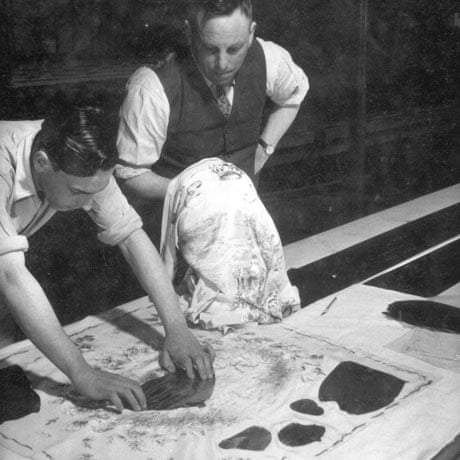Snapshot: Dad and the coronation scarf
The handsome glossy-haired young man in the picture is my dad, Brian Nicholls. He is applying gold leaf to a silk coronation scarf designed by Oliver Messel, the stage designer. Dad worked for Cresta Silks (previously Crysede), mainly as a block printer, in St Ives, Cornwall in the early 1950s. Cresta Silks fabrics were sold to Liberty and others, from the 1920s to the 1960s, and the coronation scarf was a limited edition – the Queen Mother and Princess Margaret were each given one.
This image is from a photo session of crafts and artistic traditions of Cornwall, taken for an Australian magazine produced for homesick expats to remind them of good old Blighty. Asked why he had been chosen out of all the workers for the photograph, Dad replied, "I was the best-looking, of course."
Dad was taken on as a scholarship boy from the grammar school. His father had been a dyer under the manager, Tom Heron – father of the artist Patrick Heron.
The Cresta Silks factory was based in Hayle, a 14-mile return journey, which Dad made daily on his long saved for bike. Interviewed recently by textile artist Vivian Prideaux for a book on Cresta/Crysede, she asked what happened when he was late, dad was nonplussed and asked what she meant. "Well, if you were late for work," Vivian clarified.
I intervened: "Oh no, he would never be late – Dad is never late."
And he isn't. Dad is 80 this year and you can still set your watch by him. He loved his work and the connection with the great artists who designed for the company: Graham Sutherland, Paul Nash and Heron himself. His energy and enthusiasm for life is undimmed, he twinkles. His hair now a wispy white and a smile is perpetually breaking. At a recent dinner party, an old friend said he didn't know anyone who was truly happy, I said I did: my dad.
Dad worked at the Hayle factory until 1954. A year later, he met our mother to whom he was happily married until her death in 1986. Together they had three children: myself, my sister Karen and my brother Stephen. We were loved and adored. He remarried, again happily, to Jean and she suffers his competitiveness over Countdown, crosswords and sudoku with tolerance and good humour. I am now a fabric designer (I named the company Betty Boyns, after our mother) and Dad couldn't be more delighted. But that is his nature – he is proud of us all and lets us know.
During the interview, Vivien showed us the original Oliver Messel scarf. The design is stunning, embodying 1950s style, and the gold leaf sparkles even after 60 years, as does our dad. Happy coronation year, Brian. Paula Nicholls
Playlist: Uncle Jack, star of the Gaumont
La Vie en Rose, played on the cinema organ
Uncle Jack had taught himself to play the organ to a professional standard. When I was very young he lived in a flat opposite the Gaumont cinema and supplemented his pay from the electricity board by playing for the picture-goers in the interval. I often think that his life would have been perfect if those days had continued.
Like most cinemas, the Gaumont parted with its organ and Uncle Jack had to travel further for musical engagements. Once he appeared on television, accompanying the rollerskating at Alexandra Palace. He and Auntie Joan now lived in a small house with their two children and a cat called Tibia, the name of an organ stop. In pride of place in their sitting room was a cinema organ, and on visits we would listen to him playing popular tunes. "Play La Vie en Rose, Jack!" Auntie Joan would say, and we would listen contentedly to the sentimental tune.
But life was not always rosy for Jack and his family. The evening gigs were getting further away, in distant pubs, sometimes at seaside resorts. As the travelling increased he gave up his steady day job to concentrate on his music. There was a streak of extravagance in both aunt and uncle, and in his case it generally involved buying second-hand organs. Finally they separated and he settled in a seaside resort. We saw him less often, but a recording of a cinema organ or the tune La Vie en Rose would revive childhood memories. Uncle Jack died suddenly after a brief illness. At his funeral they played his own recording of popular tunes on the cinema organ. It was the way he would have wanted it. Rosemary Goodacre
We love to eat: Garage chicken
Ingredients
A roast chicken
Lots of crispy roast potatoes sprinkled with sea salt (Maris Pipers preferably)
Assorted salad items & dressings
A garage
When the days get longer and warmer, our Sunday-night roast gives way to Garage Chicken. Buying a dartboard last year inspired us to transform our garage into what we now call the social club. It is no glamorous affair, but complete with a couple of optics, makeshift bar area and soon to be installed woodburning stove, it is the ideal spot to sit and shelter from cool winds, enjoying the last few rays of the day's sun.
On evenings that are too sunny to eat inside, but slightly too chilly to warrant a barbecue, the four of us can be found running backwards and forwards from kitchen to garage, assembling our feast of a simple roast chicken, roast potatoes sprinkled liberally with sea salt and whatever salad and dressings we can pull together. We eat at an old garden table in mis-matched chairs, pulling every last scrap of chicken from the bones and licking our salty fingers. Who cares if food gets on the floor or if we spill wine on the table … as my nine-year-old son says: "I don't know why, but the food always tastes better out here." Sabia Morrison
